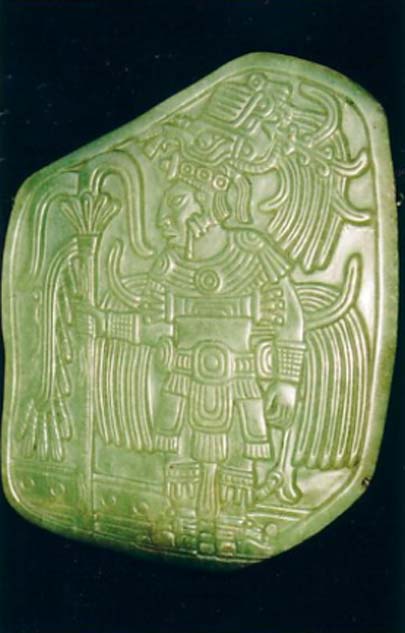
New Discovery Suggests That Maya Elites Danced Wearing As Much As 25 Pounds of Jade Jewelry
A five-pound jade head pendant has been found at Ucanal, an archaeological site in what was once the Maya city of K’anwitznal.
The massive jade pendant, the heaviest of its kind ever found, once hung off of the belt of a Maya elite while he danced. It is believed that this is just one of many pieces of jewelry he would wear during ritual dances. This Maya elite, like many others, would dance with 25 pounds hanging off of his body.
The jade head pendant is more than just a piece of jewelry. It’s a fascinating new insight into the grueling and brutal rituals of Maya dances. It’s a sign of just how mercilessly Maya elites would weigh themselves down before dancing, and it’s opened up a new insight into the significance of Maya jewelry.

Jade head pendant weighing 5 pounds (2 kg) was found recently in Ucanal Guatemala. (Image: Left, Halperin, C et al; Right, Christina Halperin)
Maya Dance and the Spirit World
Dancing, for the Maya, was more than just a way to pass the time. The Maya danced to communicate with their gods. By leaping and moving, they believed that they could bring themselves into a trance-like state that would bring them into another, more spiritual world.
The Maya would dance in masks and costumes, dressing themselves up as birds, jaguars, or strange monsters. Their dances, they believed, had the power to transform into these creatures, which they called their “wayibs” or “spirit companions”.
Dancing was a way for them to become more than just men. It was a way for mortals to enter into the spirit realm. When the Maya danced, a whole crowd of people would leave their bodies behind and enter the domain of the gods.
- Ancient North Americans Played High-stakes Games
- Loltun Cave Art and Precious Clues to the Lost Mayan Civilization
- An Ancient Maya City Founded by a God and Conquered by a Death Cheating Despot

Jadeite pectoral adornment from the Maya Classic period. (CC BY-SA 3.0)
Maya Dance as Mass Hallucinations
The crass, hard reality, though, is that all those spiritual experiences the Maya enjoyed while they danced were almost certainly just mass hallucinations.
Maya writings and images make it clear that drugs and alcohol were a major part of their ritual dances. Some, inscribed with dedications to the god of alcohol, show the Maya priests ending a long ritual of drink and dance by kneeling over and vomiting.
The Maya credited the incredible experiences they had to the rhythms of their dances. To a certain degree, it surely played a role. But as beautiful as the thought of a dance turning a mortal man into a spirit creature might be, there’s no denying that hallucinogenics played a role.

Maya musicians and dancers, Bonampak mural. (Public Domain)
Self-Harm and Hallucination
The dance itself, though, was still a major part of their spiritual experiences. They were working together in a combined, physically exhausting ritual, all building toward the same purpose and – as a result – the same hallucination.
A lot of that came through pain. On the sites of Maya ritual dances, archaeologists have found countless bloodletting tools. The Maya, they believe, would often cut themselves with sharp spines, bones, and blades to release their blood before dancing, helping them bring on those transcendental experiences through sheer exhaustion.

Maya relief showing bloodletting rite, with the lady on the right pulling a thorny rope across her tongue. From Yaxchillan, Chiapas, Mexico, Maya, about AD 725. (CC BY-NC 2.0)
Surely, in part, the great weight of the jewelry the Maya elites hung off of their bodies must have helped wear them down. In a way, it must have helped physically exhaust them and break them down to that point that brought on these spiritual experiences.
- Teen Makes Stellar Discovery of Previously Unknown Maya City
- Yucatan Children Learn Math Better Thanks to Ancient Mayan Numeral System
- Calakmul: Ancient Maya City of the Two Pyramids and Three Stones

Late Classic (650-850 AD) Maya face pendant. (CC BY-SA 3.0)
The Weight of Maya Jewelry
The weight, though, likely held a deeper significance. Weight was something unique to the Maya elites. They would dance in great, heavy belts weighed down with shells, pendants, and jewels. Rulers would often hold a scepter and shield in their heads while they dance, and weigh down their heads with mosaics made of shell.
In part, it was meant to be beautiful. All the jewels and decorations hanging from their waists, swaying with the dance, were a gorgeous sight to behold.
Historian Christina Halperin, however, believes that the massive weight of this jade pendant might reveal a special significance that all this jewelry may have held. The way they weighed elites down might not have been an unfortunate side-effect to beauty, she believes; instead, it might have been the whole point.

Royal belt ornament (tzuk), Maya, southern Maya lowlands, Mexico or Guatemala, Late Classic period, c. 600-900 AD, jadeite - Dallas Museum of Art. (Public Domain)
The Burdens of Office
Maya elites may have worn just heavy jewelry, Halperin believes, as a symbolic reminder of the weight of the burden of office.
The Maya had a concept they called “kuch”, a word that can be roughly translated to “burden”. A “kuch” could be a guilt, a physical weight, or – most significantly – a responsibility, like the responsibility of public office.
A Maya elite’s “kuch” was the weight he owed his community. It was a way to remind him that he was not in this position as a freedom or a luxury; instead, he was there to serve his fellow Maya.
Halperin believes that the great weight of jewelry, like this Jade head, was meant to be a very physical and concrete reminder of their burdens. Every time they danced, they would be literally weighed down by their office.
The Maya who wore that five-pound head on his belt was likely a priest. He would have been living in the ceremonial center, leading the people in ritual dances and spiritual experiences that connected them with the gods.
But with every movement he made, he would have a hard reminder that this was not just fun and games. He had a sacred duty to uphold and a whole a community relying on him. And with every step of his foot, he would have felt the weight of that duty dragging him back down to the earth.
Top image: This is an artist's copy of a mural at the Temple of the Murals at Bonampak, a Maya archaeological site showing examples of heavy jewelry. Source: CC BY-SA 3.0
By Mark Oliver
References
Haplerin, Christina T.; Zachary X. Hruby; and Ryan Mongelluzzo. “The Weight of Ritual: Classic Maya Jade Head Pendants in the Round.” Antiquity. June 2018. Pp. 758-771. https://www.cambridge.org/core/journals/antiquity/article/weight-of-ritual-classic-maya-jade-head-pendants-in-the-round/EB6B7C63B57A6B0FAB2179FE62F4FAA0
Looper, Matthew G. To Be Like Gods: Dance in Ancient Maya Civilization. University of Texas Press. 2009. https://books.google.com/books?id=2i_lDAAAQBAJ&printsec=frontcover#v=onepage&q&f=false
Pharo, Lars K. The Ritual Practice of Time: Philosophy and Sociopolitics of Mesoamerican Calendars. Brill. 2014. https://books.google.com/books?id=SHZfAgAAQBAJ&printsec=frontcover#v=onepage&q&f=false
“The Wayib: Maya Spirit Companions.” Rise of Civilization. Michigan State University. April 22, 2013. Web. http://anthropology.msu.edu/anp363-ss13/2013/04/22/the-wayib-maya-spirit-companions/
Urbanus, Jason. “World Roundup.” Archaeology. Archaeological Institute of America. Sept. 2018. https://www.archaeology.org/issues/311-sep-oct-2018/world
















Comments
The self-harm noted is Man's attempts to atone for sin. Monks and nuns should have known better.
The Son of God has paid for the sins of the world. Anyone who refuses His payment has to pay himself.
No problem, sharing info is great - how else can we learn of what is around us =)
I'm glad that Aruvqan included the Dervishes in his Comment. They came to my mind nearly immediately as I was reading the article as I have seen several videos thru the years on their customs. Thank you for your observation Aruvqan !
Puts me in mind of the ecstatic dancers of India [they dance with things piercing them, and frequently arrays of spikes in a semicircular frame] and the sun dances of the American indians - they would do the skin piercing thing and dance around tethered to a pole until they passed out or the hooks tore through the skin. There are also the Dervishes, though they twirled to self hypnotize, they didn't add weights. Christian monks and nuns and some laypeople would starve themselves through almost constant fasting and self flagelation to get in touch with God as well.
Face it, there is a definite link to self abuse and religious enlightenment, whether it is fasting, pain, dance or arduous pilgrimmages.